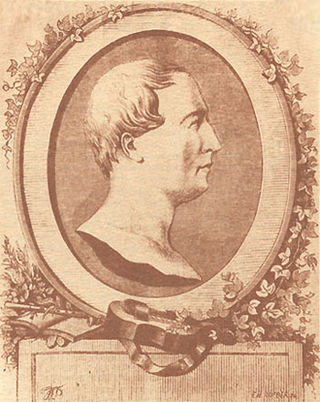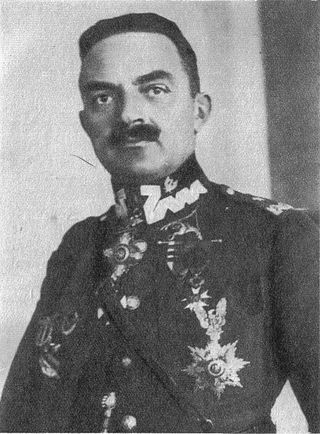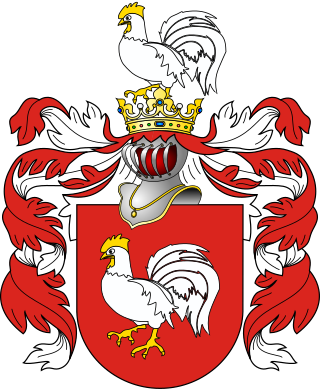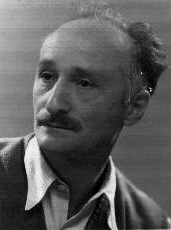
Mieczysław Karłowicz was a Polish composer and conductor.
Stanisław Saks was a Polish mathematician and university tutor, a member of the Lwów School of Mathematics, known primarily for his membership in the Scottish Café circle, an extensive monograph on the theory of integrals, his works on measure theory and the Vitali–Hahn–Saks theorem.

Polish heraldry is the study of the coats of arms that have historically been used in Poland and the Polish–Lithuanian Commonwealth. It treats of specifically Polish heraldic traits and of the Polish heraldic system, contrasted with heraldic systems used elsewhere, notably in Western Europe. Due to the distinctive ways in which feudal societies evolved, Poland's heraldic traditions differ substantially from those of the modern-day German lands and France.

Zygmunt Szendzielarz was the commander of the Polish 5th Wilno Brigade of the Home Army and after the Second World War fought against the Red Army.

Jan Czeczot of Ostoja was a Polish romantic poet and ethnographer. Fascinated by the folklore and the traditional folk songs of the former Grand Duchy of Lithuania, a confederal part of the Polish–Lithuanian Commonwealth, he recollected hundreds of them in his works. Inspired by them, he also wrote several poems in what could be considered a pre-modern Belarusian language. As such, he is often cited as one of the first Polish ethnographers and one of the predecessors of the Belarusian national revival.

Stanisław Masłowski was a Polish painter of realistic style, the author of watercolor landscapes.

Joseph Stanislaus Ostoja-Kotkowski AM, FRSA was best known for his ground-breaking work in chromasonics, laser kinetics and 'sound and image' productions. He earned recognition in Australia and overseas for his pioneering work in laser sound and image technology. His work included painting, photography, film-making, theatre design, fabric design, murals, kinetic and static sculpture, stained glass, vitreous enamel murals, op-collages, computer graphics, and laser art. Ostoja flourished between 1940 and 1994.

Jan Brunon Bułhak (1876–1950) was an early 20th century photographer in Poland and present-day Belarus and Lithuania. A published theoretician and philosopher of photography, he was an exponent of pictorialism. He is best known for his landscapes and photographs of various places, especially the city of Vilnius. He was the founder of the Wilno Photoclub and Polish Photoclub, the predecessors of the modern Union of Polish Art Photographers (ZPAF), of which he was an honorary office-holder. He is also known as an ethnographer and folklorist.

Włodzimierz Zagórski of the Clan of Ostoja was a Polish brigadier general, military intelligence soldier of the Austro-Hungarian Army, staff officer and aviator.

Kur is a Polish coat of arms. It was used by several noble families forming a Clan of Kur in the times of the Kingdom of Poland and the Polish–Lithuanian Commonwealth. It is noted during the reign of the Jagiellon dynasty and illustrated with its original name in the work of Bartosz Paprocki "Herby Rycerstwa Polskiego" in 1584. Furthermore, it is published in the work of Szymon Okolski in 1641. and several other publications
Antoni Milkowski (1935–2001) was an American minimalist sculptor.

Antoni Adam Piotrowski was a Polish Romanticist and realist painter who worked as war correspondent and illustrator for various Western European weeklies and periodicals in late-19th century during the Liberation of Bulgaria.
Arthur Okamura was an American artist, working in screen printing, drawing and painting. He lived in the San Francisco Bay Area, and was Professor Emeritus at the California College of the Arts in San Francisco, California. His work is in the permanent collections at the Smithsonian Institution in Washington, D.C., the Whitney Museum in New York, and the San Francisco Museum of Modern Art. He is associated with the San Francisco Renaissance. He illustrated numerous works of literature and poetry, published a book on games and toys for children, and created illustrations for the TV movie The People.

The Clan of Ostoja was a powerful group of knights and lords in late-medieval Europe. The clan encompassed families in the Polish–Lithuanian Commonwealth, Hungary and Upper Hungary, Transylvania, and Prussia. The clan crest is the Ostoja coat of arms, and the battle cry is Ostoja ("Mainstay") or Hostoja ("Prevail"). The clan, of Alan origin, adopted the Royal-Sarmatian tamga draco (dragon) emblem.

Antoni Baranowski of Clan Ostoja, general major of the royal army, patriot.
Andrzej Krauze is a Polish-born British cartoonist, illustrator, caricaturist, painter, poster designer and satirist noted for his allegorical, fabulous, symbolic and sometimes scary imagery, as well as his reliance on black ink, bold lines and cross-hatching. His illustrations have been a regular fixture in the British national daily newspaper The Guardian since 1989, and he has also contributed to the English-language newspapers and magazines The New York Times, The Sunday Telegraph, The Times, International Herald Tribune, New Scientist, The Independent on Sunday, The Bookseller, New Statesman, Modern Painters, Campaign, The Listener, New Society and Story Teller. He won the Victoria and Albert Museum Award for Illustration in 1996, and the Ranan Lurie Political Cartoon Award in 2003.

Alexander Bogen was a Polish-Israeli visual artist, a decorated leader of partisans during World War II, a key player in 20th century Yiddish culture, and one of the trailblazers for art education and Artists' associations in the emerging state of Israel.

Wincenty Danilewicz - Chevau-léger in the Napoleonic campaign, secretary of Chancellery of Senat in Congress Poland, chief archivist of heraldric administration of Congress Poland in Warsaw.

George Him was a Polish-born British designer responsible for a number of notable posters, book illustrations and advertising campaigns for a wide range of clients.

Clan Ostoja (Moscics) is one of the largest and oldest knightly and heraldic families in Europe, belonging to the Polish nobility. The family is sealed with the Ostoja coat of arms.















